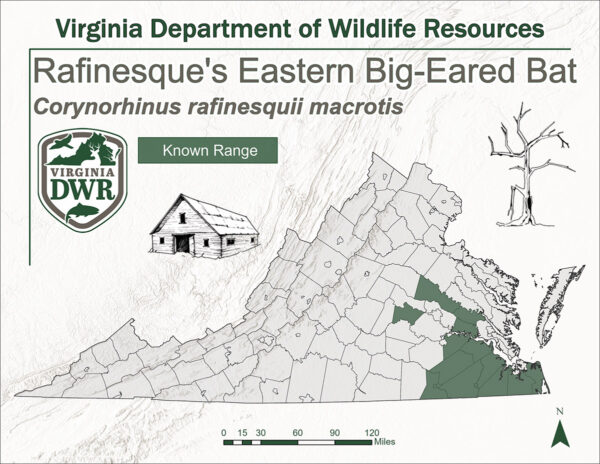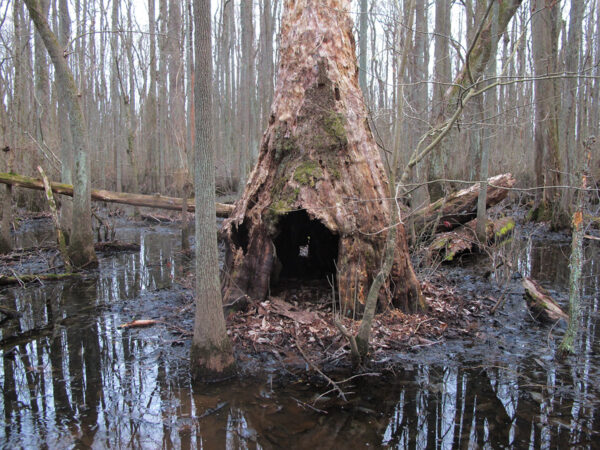Rafinesque's Big-eared Bat. © Ken Conger.
A Rafinesque's Big-Eared Bat roosts in a cavity. Photo by ©James Kiser
Fact File
Scientific Name: Corynorhinus rafinesquii macrotis
Classification: Mammal, Order Chiroptera, Family Vespertilionidae
Conservation Status:
- State Endangered in Virginia
- Species of Greatest Conservation Need-Tier 1a on the Virginia Wildlife Action Plan
Distribution
Rafinesque’s big-eared bats are found throughout the Southeastern United States from Virginia, southern West Virginia, Ohio, Indiana, and Illinois, south through the lower Mississippi Valley through southeastern Missouri, central Arkansas, southeastern Oklahoma and eastern Texas to the Gulf and Atlantic coasts. In Virginia, Rafinesque’s big-eared bats are found in bottomland hardwoods and swamps in the Coastal Plain.

Identifying Characteristics
The Rafinesque’s big-eared bat is, aptly, known for its large ears, which can measure 1.25 inches long, are pointed, and stand vertically. The ears equal about a third of the length of this medium-sized bat, which is usually between 3.5 and 4.2 inches long. With a wingspan of about 11 inches, they weigh less than an ounce. Another identifying characteristic of this species is the two large glands on the upper surface of their snout.

A DWR Biologist examines a Rafinesqeue’s eastern big-eared bat. J.D. Kleopfer/DWR
With long, soft, and gray-brown fur on their back, the Rafinesque’s has belly fur tipped with white, providing silvery contrast to the bicolor fur on the back. They have long toe hairs that extend past the tips of their claws.
Those long toe hairs are one of the few details that distinguish the Rafinesque’s big-eared bat, a species that resides in the coastal localities of Virginia, from the Virginia big-eared bat (Corynorhinus townsendii virginianus), which can be found in a few counties on the western edge of Virginia. The Virginia big-eared bat has short toe hairs, as well as a more brown body color and cream belly color.

Rafinesque’s big-eared bat clinging to a rock. John MacGregor/Kentucky DFWR Photo
Habitat
The Rafinesque’s big-eared bat is a cave or tree bat depending on geographic location. Along the coast and in the southeastern United States, Rafinesque’s big-eared bats roost in hollow trees and old buildings year-round. They prefer mature, bottomland, hardwood forests, commonly known as river swamps with gum, oak, and bald cypress growing in areas that are either covered with water or flood seasonally.

A Bald Cypress tree that would be a possible roost site for the Rafinesque’s eastern big-eared bat. J.D. Kleopfer/DWR
As these habitats have become less available, they also utilize abandoned buildings. In states farther north and west of the Appalachian mountains, they can be found in caves and mines.

One of the largest known roost sites anywhere in the Rafinesque’s big-eared bat’s range, this early 1900s African American schoolhouse hosts up to 70 females that give birth and raise their young in the building. The building was in need of significant repairs to keep it from collapsing. A Bat Conservation Internation (BCI) grant enabled DWR to put a new roof on it and shore up one of the walls to preserve this important breeding habitat. J.D. Kleopfer/DWR
Diet
Moths make up to 90 percent of the diet of Rafinesque’s big-eared bats, with beetles and other flying insects comprising the rest of their diet. They’re a nocturnal species, flying short distances to forest edge and forest areas to forage.

A Rafinesque’s big-eared bat hunting for prey. John MacGregor/Kentucky DFWR Photo
Reproduction
Reproduction occurs in fall through winter when males and females move to their wintering sites. Females will form maternity groups of a few to as many as 100 individuals. Through delayed fertilization, a single litter is produced in late spring or early summer (early June through mid-July). Gestation is about 55 to 100 days; the young begin to fly at about three weeks and are weaned at about six weeks of age.

A cluster of Rafinesque’s big-eared bats. Ken Conger/DWR
Conservation
The primary threats to the species are habitat-focused—loss and degradation of coastal bottomland hardwood forests due to urban expansion and agricultural conversion. Conservation actions to support the species focus on the protection and enhancement of bottomland hardwood forests. Interestingly, the Rafinesque’s big-eared bat has not seemed to suffer from White-Nose Syndrome, the fungal disease that has affected some other species of hibernating bats, decreasing their populations.
Did You Know?
The Rafinesque’s big-eared bat bears the name of Constantine Samuel Rafinesque, a naturalist who came to the United States from France in 1815. Rafinesque collected and named hundreds of species of plants and animals.

Artist’s rendition of Rafinesque’s Eastern Big-Eared Bat. Illustration by ©Brittany Fernald
Last updated: December 10, 2025
ShopDWR
Order your copy of A Guide to the Bats of Virginia, along with more gear, guides, and gifts!
Visit ShopDWRThe Virginia Department of Wildlife Resources Species Profile Database serves as a repository of information for Virginia’s fish and wildlife species. The database is managed and curated by the Wildlife Information and Environmental Services (WIES) program. Species profile data, distribution information, and photography is generated by the Virginia Department of Wildlife Resources, State and Federal agencies, Collection Permittees, and other trusted partners. This product is not suitable for legal, engineering, or surveying use. The Virginia Department of Wildlife Resources does not accept responsibility for any missing data, inaccuracies, or other errors which may exist. In accordance with the terms of service for this product, you agree to this disclaimer.

